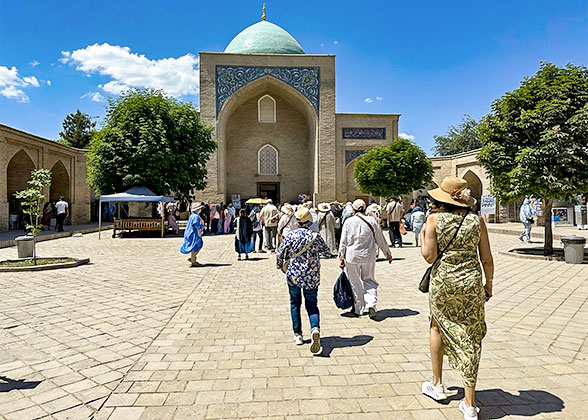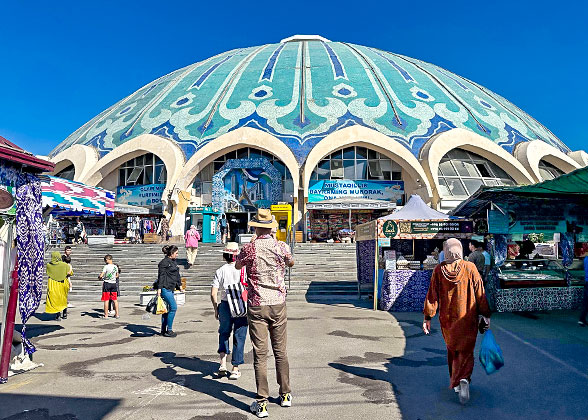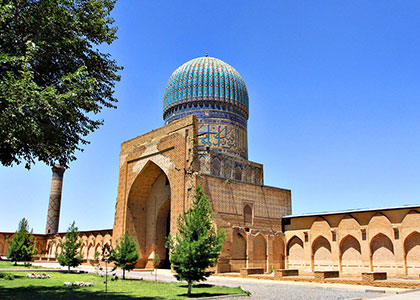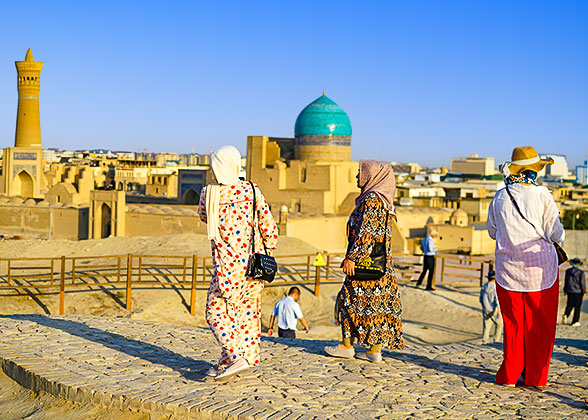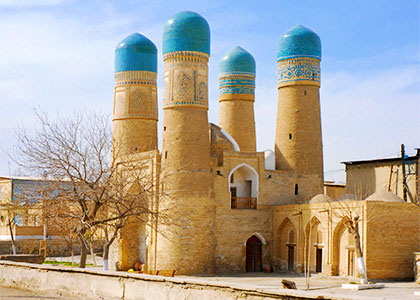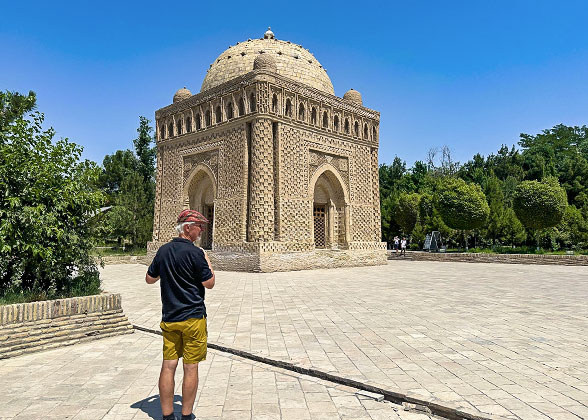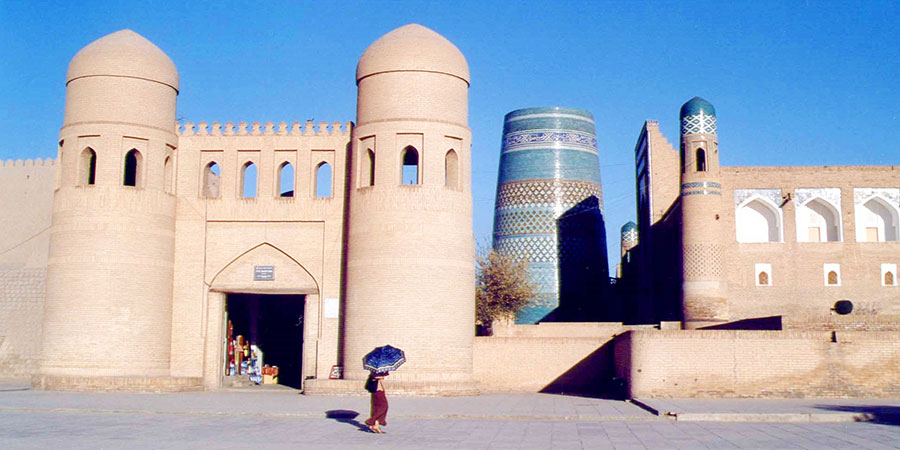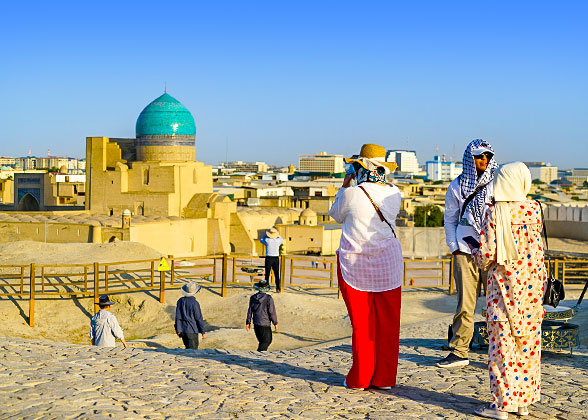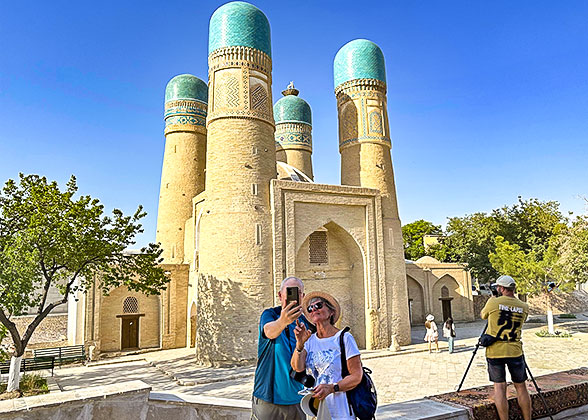Day 1: Airport Pick-up; Tashkent Highlights: Khast-Imam Complex, State Museum of Applied Art
Plov Center in Tashkent Welcome to the first stop of your classic Uzbekistan tour packages, Tashkent! Upon arrival, our driver will pick you up at the airport and transfer you to the hotel for check-in. With a history spanning over two millennia, Tashkent emerged as a pivotal hub along the ancient Silk Road since the 6th century. In 1220, the city was devastated by Genghis Khan, but later revived by Timur during the 14th-16th centuries. Its tumultuous past has bequeathed a rich legacy which is most vividly embodied in its architecture. After a short break in the hotel, the guide will first accompany you to the Khast-Imam Complex, standing on Tashkent’s most iconic square, which offers an immersive introduction to the Islamic architecture of Uzbekistan. Dominating the plaza is the Tilla Sheikh Mosque, which was once the city’s primary sanctuary. Stepping into the mosque, you’ll see its sandalwood pillars from India and amber-hued walls shimmering with green marble from Turkey and turquoise tiles from Iran. The white dome above is adorned with intricate gilded patterns. When sunlight streams through the windows and illuminates sapphire carpets, the mosque will look more sacred. Besides, the 16th-century Islamic school - Barakh-khan Madrasah, the tomb of a 10th-century philosopher and poet - Abubakr Kaffal-Shashi Mausoleum, and the Islamic Institute of Imam al-Bukhari, are all worth a visit. Then, we will continue to the Chorsu Bazaar, covered by a huge, green and ger-shaped dome, where you can see the sellers pile the fruit in a pyramid shape, smell the mixed flavor of spices, and hear the bargaining. Cross the bazaar and step into the State Museum of Applied Art, a place where even the walls are artworks, and its facades will dazzle your eyes with cobalt-and-emerald carvings. In addition, it holds over 7,000 artifacts from the 19th century onwards, such as pottery from the Fergana Valley, and Suzani embroidery decorated with kaleidoscopic patterns from Bukhara, revealing the artisans' souls of the country. Afterwards, descend to the underground to explore the remnants of the Soviet Union, Tashkent subway stations, each of which has its own theme and style. For example, the Independence Square Station (Mustakillik Maydoni) features grand marble-clad columns whose tops are designed in a pedicel shape supporting the ceiling hung with opulent chandeliers. We will get off at Independence Square and wander to the adjacent Amir Timur Square. The Tashkent sightseeing will end after mourning for the victims of the 1966 earthquake at the Earthquake Memorial.  Things to Know: 1. Visa: Visitors from 66 countries, including the UK, Canada, and the EU, enjoy a visa-free policy. Individuals from 50 countries, including the US, are required to apply for an e-visa 1-2 weeks before departure. US travelers under 16 and over 55 years old can also enter Uzbekistan without a visa. 2. Plug Adapter: The European standard (Type C or Type F) socket is mainly used in Uzbekistan. Please remember to prepare suitable plug adapters if needed. 3. Currency: The Uzbek som (UZS) is the official currency. Visa and Mastercard are accepted in some large hotels or restaurants, but cash still dominates bazaars and small stores. Hence, we suggest you exchange some UZS cash at ATMs. Please note that most machines only accept Visa, Maestro cards, and USD cash. USD 200-300 is enough for an 8-day trip. Accommodation: Wyndham Tashkent (4 stars) or similar
|
Day 2: High-speed Train to Samarkand: Visit Registan Square, Bibi Khanym Mosque, Shah-i-Zinda Necropolis
After breakfast, you’ll be escorted aboard a morning high-speed train to Samarkand. The 300-kilometer (186-mile) journey will take about 2 hours. Unlike Tashkent, which is scattered with Soviet-era buildings, Samarkand breathes an air of classical Central Asia, with its skyline dominated by a uniform collection of Islamic structures. Our journey in Samarkand will begin at Registan Square, the pinnacle of Timurid architecture, which has been the heart of the city all the time. The Khans once issued edicts here, and now it has become a hub for citizens. The plaza is surrounded by three madrasahs, among which the Shir Dor Madrasah may command your immediate attention with its portal blazed with mosaic figures of two lions with human-faced suns on their backs. Then, wandering across the Siyob Bazaar, we’ll stop at the Bibi Khanym Mosque, built by Timur during 1399-1404 as a gift to his wife Bibi Khanym. Standing in its yard, you’ll see its blue dome with a corrugated surface and a marble countertop on which a huge Koran is showcased. Continue driving to the Ulugbek Observatory in the suburbs to see Ulugbek’s manuscripts and the original observatory model in its museum. Finally, head to the Gur-Emir Mausoleum, where Timur rests, and the Shah-i-Zinda Necropolis, the most beautiful mausoleum complex in Central Asia, where the female members of Timur’s royal family are buried. Both of them will feast your eyes with gleaming, starry-sky-like domes.  Samarkand-Wrecker: Genghis Khan As the most prosperous city of the Khwarezmian Empire in the 13th century, Samarkand became a stumbling block for Genghis Khan’s westward expedition. The Khan’s cavalry encircled the city for 8 days, during which the villages around were slaughtered. Under such huge pressure and Genghis Khan’s hollow mercy, the defenders finally surrendered. But as soon as the Mongol army entered the city, thirty thousand Samarkand soldiers were executed. Artisans and craftsmen were enslaved as military laborers, and other civilians became shields for the next siege. Only the wealthiest citizens bought their lives with ransom. Meals: Breakfast Accommodation: Grand Samarkand Superior (4 stars) or similar
|
Day 3: Samarkand: Afrasiab Museum, Tomb of Saint Daniel, Koni Ghil Village
Today’s Samarkand tour starts from the Afrasiab Museum. Housed on the mound where Marakanda, the legendary capital of Sogdia, thrived since 323 BC, the museum stands as a Sogdian cultural touchstone. The Sogdians, a merchant ethnic group, used to construct a trade network from China’s Chang’an to Rome, with Samarkand as one of their most important settlements along the way. In the main hall of the museum, you can see 7th-8th century murals that combine Persian miniatures and Chinese Tang-dynasty motifs. It’s interesting to decode the stories depicted in the murals, such as the scene of Sogdian monarchs receiving envoys from China, Turkic khanates, and Persia. Besides, dilapidated ossuaries, fractured weaponry, coins, and ceramic shards are all whispers of Sogdian tales. Moving northward from the museum, we’ll visit the coffin of the Jewish prophet Daniel in the Bible at the Tomb of Saint Daniel. There is a legend that says his remains grow ceaselessly, compelling locals to extend the sarcophagus, now stretching 18 meters (59 feet). Please remember to take off your shoes and dress conservatively when entering the sacred tomb. ★ Watch the Paper-making Process at Koni Ghil VillageAfter that, we’ll drive to the Koni Ghil Village, where a 1990s-built paper factory preserves the 8th-century paper-making technique. You can witness how artisans transform mulberry branches into paper and browse some paper-making artworks, such as paper clothes embroidered with patterns, notebooks, and postcards. The village also features a river flowing nearby, above which are more than 200 waterwheels. You can ramble along the river or have a rest in the teahouse, tasting Uzbekistani tea or plov on your own. Later, you’ll be sent back to the hotel in Samarkand.  Night Activity Suggestion: If you want to hang around in Samarkand on your own, Registan Square is highly recommended. At around 19:00, the square is illuminated by lights, and a free ordinary light show may be held at 20:00 or 21:00, lasting about 30 minutes. Until you see colorful lights flashing on the façades of madrasahs, you’ll never think that religious buildings could be so cybernetic. If lucky, an occasional luxury 20-minute 3D show tailored by the rich at 19:00 will leave an unforgettable memory of your journey. For an immersive experience of the 3D show, you can pay UZS 65,000 (USD 5) for a front-row seat; however, you can also stand at the edge of the square to view it for free. Meals: Breakfast Accommodation: Grand Samarkand Superior (4 stars) or similar
|
Day 4: Train from Samarkand to Bukhara: Kalyan Minaret, Miri-Arab Madrasah, and Chor-Minor Madrasah
Amir Temur Mausoleum After breakfast, you’ll be escorted to the railway station for a 2-hour high-speed train to Bukhara, which is believed to be the cradle of the book - Tales from the Thousand and One Nights (also known as The Arabian Nights). Compared to the sumptuous Samarkand, Bukhara shows simplicity in amber-colored sandstone without too much adornment. Upon arrival, you’ll be escorted to the handpicked hotel for check-in. After a short break, our walking tour will start from the 45-meter-high (147-foot) Kalyan Minaret, one of the highest buildings in Bukhara. It is said that the foundation of the minaret was built with bricks made of alabaster mixed with camel milk. To prove its solidity, its architect, Bako, made a will to be buried 45 meters (147 feet) away from the base after he passed away and declared that if the minaret fell, it would fall on his head. Adjacent to the minaret, Kalyan Mosque and Miri-Arab Madrasah face each other, whose iwans, the portals of Islamic buildings, gleam with geometric and botanical patterns in blue-and-white tilework. If interested, come back here again at dusk to capture the silhouette of the minaret and mosque when the buildings are bathed in the soft, golden hues of the setting sun. Then, continue to Bukhara’s oldest mosque, Magoki-Attori Mosque. Passing the Islamic institutions, Ulugh Beg Madrassah and Abdulaziz Khan Madrassah, we will step into the Trade Domes Market, where you can see various Uzbek traditional artworks such as miniatures, embroideries, wooden sculptures, and traditional clothes. Crossing the Lyabi Hauz Ensemble filled with various stylistic restaurants, coffee shops, galleries, and souvenir shops, we’ll stop at today’s last destination - Chor-Minor Madrasah. Once featured on Lonely Planet Central Asia’s cover, it houses four uniquely designed blue towers. Some say that each one represents a dynasty: Karakhanid (840-1212), Samanid (875-999), Shaybanid (1500-1599), and Manghit (1785-1920), while others think of the towers as a symbol of the four religions: Zoroastrianism, Buddhism, Judaism, and Islam, and the central dome signifies the shared universe. You may find Buddhist prayer wheels and Christian crosses on their blue tops. Standing at the right side of the madrasah and snapping a photo with a wide-angle lens, you could recreate the cover of the Lonely Planet. Meals: Breakfast Accommodation: Volida Hotel Bukhara (3 stars) or similar Kalyan Minaret, Bukhara Chor-Minor Madrasah
|
Day 5: Bukara Exploration: Ark Fortress, Bolo Khauz Mosque, Summer Palace
Today, we’ll first visit the Ark Fortress. Dating to the 1st century, it served as the residence for Bukhara’s rulers and their kin. You can discover hand-copied Quran manuscripts in its mosque, see photos of royal steeds in the stables, and admire gifts from foreign dignitaries in the square’s museum. Then, ascend the ramparts for panoramic views of the ancient city and fortress complex. Head westward, and Bolo Hauz Mosque will welcome you with its 20 wooden pillars at the doorway, and their reflections on the water of the octagonal pool in front of the mosque, hence earning it a nickname, ‘’the Mosque of Forty Columns." Keep going on, and a typical early Islamic building, the Samanid Mausoleum, comes into view. This millennium-old structure secures its place in the annals of world art history with its interwoven brick patterns that epitomize Persian-Islamic artistry. Drop by the Chashma Ayub Mausoleum on its northeast, which is now a museum showing the ancient water supply system, and the guide will then accompany you to the Summer Palace, also known as Sitorai Mohi Hosa. The building perfectly blends the characteristics of Europe and Central Asia, where traditional Uzbekistan miniature-decorated inner walls are hidden behind its European-style façade. In the garden of the palace, peacocks are rambling around. You can buy a bag of barley to feed these elegant birds, and bold ones may nibble directly from your hand. Last, visit the religious shrine, the Memorial Complex of Bahouddin Naqshbandi, which consists of the tomb of the saint Naqshbandi, mosques, a small Islamic school, and so on. According to a local tradition, walking three times counterclockwise around the saint's mausoleum brings good fortune.  Recommended Restaurant: (at your own expense) For a satisfying dinner, Joy Chaikhana Lounge, located near the Lyabi Hauz Ensemble, is a good choice. Situated in a restored 18th-century caravanserai, it features a triple-tiered courtyard illuminated with colorful lights. On summer nights, there may be traditional dance performances. Alongside Uzbek staples such as plov, pancakes with spinach and cheese, and beef kebabs, you can also taste some regional rarities like Qayish, noodles with tomato-lentil toppings. Since the restaurant is quite popular among customers, we suggest that you reserve a day in advance. Average Cost: USD 10-15. MasterCard, American Express, and Visa cards are acceptable. Address: 2, Sarafon Street, Bukhara Meals: Breakfast Accommodation: Volida Hotel Bukhara (3 stars) or similar Ark Fortress Samanid Mausoleum
|
Day 6: Drive 7 Hours from Bukhara to Khiva across the Kyzylkum Desert
Today, the driver will escort you on a 7-8 hour road trip along the ancient Silk Road and across the Kyzylkum Desert to Khiva. On the way, we’ll stop occasionally to admire the desert landscape. Covering about 300,000 square kilometers (115,830 square miles), the Kyzylkum Desert is the world’s 11th largest desert, with changing terrains from undulating dunes to scrublands and even shallow lakes. You can also see the Amu Darya River that marks the Turkmenistan-Uzbekistan border from afar. If lucky, rare wildlife such as the saiga antelope, desert monitor lizards, and elusive sand cats can be spotted, enriching your desert journey. ► Tips: 1. Neck pillows and motion sickness medication are essential to bumpy rides. 2. UV-protective gear and sand-proof face masks are necessary due to intense UV rays and dust storms. After arriving in Khiva, you’ll be escorted to Ichan Kala, the inner city of Khiva, for hotel check-in. Dubbed "the city closest to heaven" in the One Thousand and One Nights, Khiva has been a mecca since antiquity. There was even an old saying on the ancient Silk Road that goes, "I'd be willing to offer a bag of gold to take just one look at the ancient city of Khiva."  Recommended Restaurant in Khiva (at your own expense): Near the east gate of the inner city, Khiva Moon Restaurant is an ideal dining choice after a long road trip. It serves Shivit Oshi, a type of green noodles that can only be found in Khiva. The chef kneads flour with fresh dill juice, which gives a vibrant hue to the dough. The stewed beef, carrots, and potatoes are added as a topping on the boiled noodles. You can also eat it with sour cream, like locals always do. Average Cost Per Person: UZS 250,000 (USD 20) Address: Polvon Kori 101A, Khiva 220300 Uzbekistan Meals: Breakfast Accommodation: Hotel Asia Khiva (3 stars) or similar
|
Day 7: Khiva: Kalta Minor Minaret, Juma Mosque, Tosh-Hovli Palace, Kunya-Ark; Fly to Tashkent
Today, let’s focus on Khiva’s 2,500-year-old inner city, Ichan Kala, which is reputed as an “open-air museum” and is Central Asia’s first UNESCO World Heritage Site. First, stop at the Muhammad Aminkhan Madrasah, once Central Asia’s largest Islamic academy, which has now been renovated into a luxury hotel, allowing visits. The unfinished Kalta Minor Minaret at the entrance will captivate you with its geometric mosaic of cobalt, turquoise, and white tiles. As planned, Muhammad Amin intended to build it as Central Asia's tallest minaret, but the construction halted abruptly upon the Khan’s death, leaving the 29-meter-high (95-foot) tower unfinished. The minaret is so mesmerizing that you can even overlook the Muhammad Rahim Khan Madrasah behind it, where you can see pictures of the Khan’s coronation ceremony and a panoramic view of old Khiva. Next, we’ll go to the Juma Mosque to admire its intricately carved wooden pillars. Afterwards, head to the Tosh-Hovli Palace. Constructed with hard bricks between 1830 and 1841, it is also named the “Stone Palace,” housing over 160 rooms across three courtyards. Although the original furnishings inside were lost, it remains a pinnacle of Islamic splendor. Not far from the palace, the Pakhlavan Makhmud Mausoleum, the only building with a huge blue dome in Khiva, beckons you. Then, passing by the 57-meter-high (187-foot) Islam Khodja Minaret, we’ll stop at today’s last site, Kunya-Ark, at the heart of Ichan Kala. Built in the 12th century, the fortress houses royal residences, military barracks, and harem quarters. At its 10th-century Summer Mosque, you can see its walls adorned with blue-and-white tiles and a ceiling ablaze with ruby, amber, and gold. Peering closely, you may find potters’ signatures etched on the ceramic. If interested, you can ascend its ramparts to overlook Khiva. After the guided tour, if time permits, you can then stroll around on your own. Later, you’ll be escorted to Urgench Airport to catch a flight to Tashkent. After landing, the driver in Tashkent will pick you up and transfer you to the hotel. Meals: Breakfast Accommodation: Wyndham Tashkent (4 stars) or similar Ichan Kala of Khiva Kalta Minor
|
Day 8: Departure from Tashkent, Airport See-off
Today, your Uzbekistan packages will come to an end. Our driver will send you to Tashkent International Airport for a homebound flight. Wishing you a smooth voyage!
Beyond Islamic architecture, Uzbekistan offers profound vistas such as the Cemetery of Ships and the drying Aral Sea, and you can contact us to extend your trip. If you want to trace more legacies along the ancient Silk Road, we can also arrange bespoke journeys to Kyrgyzstan, Tajikistan, and Turkmenistan, or its historic starting point - Xi’an, China!
Meals: Breakfast
|

